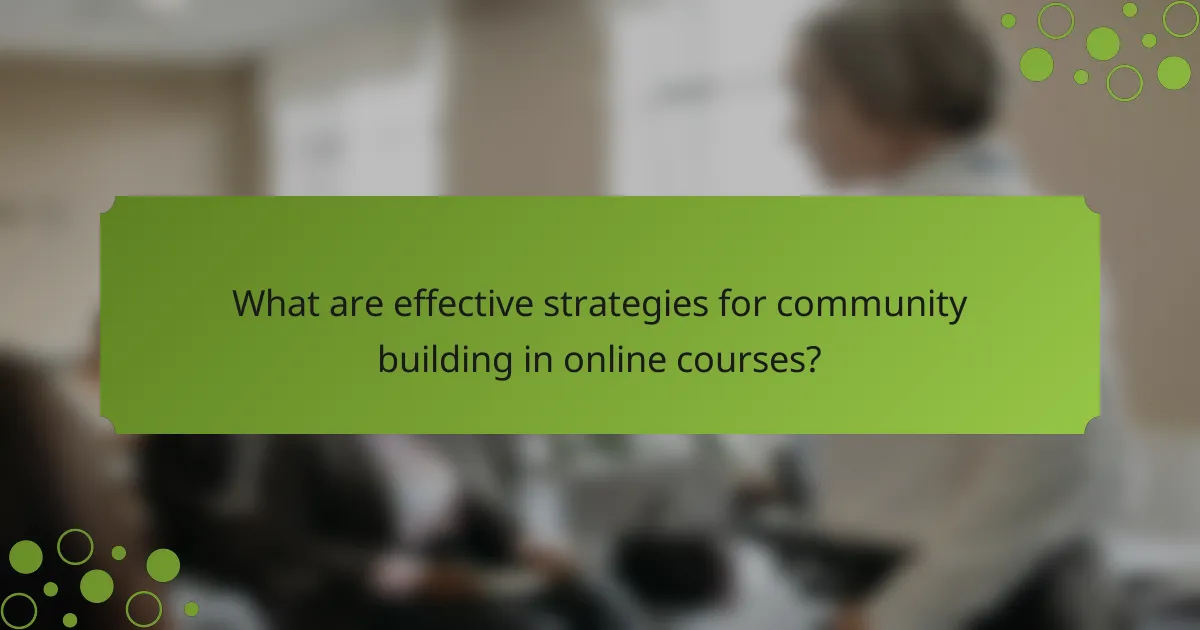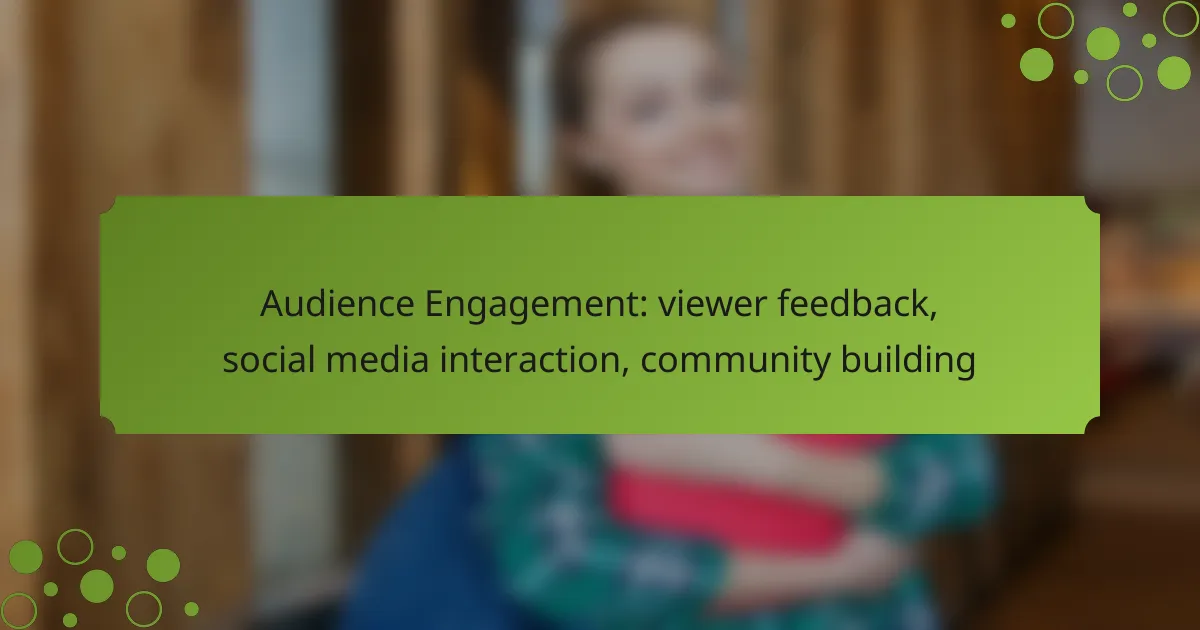Engaging an audience in online courses goes beyond delivering content; it involves creating interactive experiences that invite viewer feedback and foster community. By leveraging social media interactions, educators can enhance course visibility and build a supportive environment that encourages participation and collaboration. This approach not only improves the learning experience but also allows course creators to adapt their offerings based on learner insights.

How can online courses enhance audience engagement in Australia?
Online courses in Australia can significantly boost audience engagement by incorporating interactive elements that encourage participation and feedback. These strategies not only enhance the learning experience but also foster a sense of community among participants.
Interactive video content
Interactive video content allows learners to engage directly with the material, making the experience more immersive. Features like quizzes and clickable links within videos can keep viewers attentive and facilitate a deeper understanding of the subject matter.
For example, a course on Australian wildlife might include videos where learners can click on different animals to learn more about their habitats and behaviors. This approach can lead to higher retention rates and increased satisfaction among participants.
Live Q&A sessions
Live Q&A sessions provide an opportunity for real-time interaction between instructors and students, enhancing engagement. Participants can ask questions, clarify doubts, and receive immediate feedback, which can significantly improve their learning experience.
In Australia, scheduling these sessions during peak hours can maximize attendance. Consider using platforms like Zoom or Microsoft Teams to facilitate these discussions, ensuring that all participants feel included and valued.
Gamification techniques
Gamification techniques involve incorporating game-like elements into courses to motivate learners. This can include points, badges, or leaderboards that encourage competition and participation.
For instance, an online course could reward students with badges for completing modules or participating in discussions. This not only makes learning more enjoyable but can also lead to higher completion rates and a more engaged community.
Personalized feedback mechanisms
Personalized feedback mechanisms allow instructors to provide tailored responses to individual learners, enhancing their engagement. This can include automated feedback on quizzes or personalized comments on assignments.
In Australia, utilizing tools that allow for quick feedback can help maintain learner motivation. For example, using platforms that track progress and provide insights can help students understand their strengths and areas for improvement, fostering a more supportive learning environment.

What role does viewer feedback play in online courses?
Viewer feedback is essential for online courses as it helps educators understand learners’ needs and preferences, leading to improved course effectiveness. By actively collecting and analyzing feedback, course creators can make informed adjustments that enhance both content and delivery.
Improving course content
Feedback allows course creators to identify areas where content may be lacking or unclear. For example, if multiple learners indicate that a particular module is confusing, instructors can revise the material to clarify concepts or add supplementary resources.
Additionally, viewer feedback can highlight topics that learners find particularly engaging or relevant. This insight enables educators to expand on popular subjects or introduce new ones that align with student interests, ultimately enhancing the overall course quality.
Enhancing learner experience
Incorporating viewer feedback significantly enhances the learner experience by making courses more interactive and responsive. For instance, if students express a desire for more interactive elements, such as quizzes or discussion forums, these can be integrated to foster engagement.
Moreover, regular feedback collection can help instructors gauge the pacing of the course. If learners report that the material is moving too quickly or slowly, adjustments can be made to better align with the class’s overall learning speed, ensuring a more satisfying educational journey.

How can social media interaction boost course visibility?
Social media interaction can significantly enhance course visibility by fostering engagement and creating a community around the course content. By actively participating in discussions and sharing updates, course creators can attract a wider audience and encourage word-of-mouth promotion.
Sharing success stories
Sharing success stories from past learners can create a compelling narrative that attracts new students. Highlighting testimonials, achievements, or transformations can serve as powerful endorsements of the course’s effectiveness. Consider using video clips or written testimonials on platforms like Instagram or Facebook to showcase these stories.
When sharing success stories, aim for authenticity. Real experiences resonate more with potential learners than generic statements. Encourage former students to share their journeys and tag your course, amplifying reach through their networks.
Creating dedicated course hashtags
Creating dedicated hashtags for your course can streamline conversations and make it easier for potential learners to find relevant content. A unique hashtag can help categorize posts, making it simple for users to explore discussions, resources, and updates related to the course.
When developing a hashtag, ensure it is memorable and easy to spell. Promote the hashtag across all course-related communications, including emails and social media posts, to encourage its use. This can help build a sense of community as learners share their experiences using the same tag.
Engaging with learners through polls
Engaging with learners through polls can provide valuable insights while fostering interaction. Polls can be used to gather feedback on course content, preferred learning methods, or topics of interest, making learners feel valued and heard.
Utilize platforms like Twitter or Instagram Stories to create quick, engaging polls. Keep questions straightforward and relevant to the course to encourage participation. Regularly sharing poll results can also enhance transparency and show learners that their opinions influence course development.

What are effective strategies for community building in online courses?
Effective community building in online courses involves creating spaces for interaction, fostering connections among participants, and encouraging collaborative learning. These strategies enhance engagement and create a supportive environment for learners.
Creating discussion forums
Discussion forums are essential for facilitating communication among course participants. They allow learners to ask questions, share insights, and discuss course material, promoting a sense of belonging. Consider using platforms like Moodle or Slack, which can host threaded conversations and enable easy navigation.
To maximize participation, establish clear guidelines for forum use and encourage regular contributions. A good practice is to pose weekly discussion prompts that relate to course topics, inviting students to share their thoughts and experiences.
Hosting virtual meetups
Virtual meetups provide an opportunity for real-time interaction, allowing learners to connect on a personal level. These can be structured as Q&A sessions, workshops, or casual hangouts. Tools like Zoom or Microsoft Teams can facilitate these gatherings, making it easy to include participants from various locations.
Schedule meetups at convenient times for your audience, considering different time zones. Encourage participants to share their goals and challenges, fostering a supportive community atmosphere. Aim for a mix of formal and informal sessions to cater to diverse preferences.
Encouraging peer-to-peer support
Peer-to-peer support enhances the learning experience by allowing students to assist one another. This can be achieved through study groups, buddy systems, or mentorship programs. Encourage learners to form small groups where they can collaborate on assignments and share resources.
To facilitate this, provide guidelines on how to connect with peers and suggest platforms for communication, such as WhatsApp or Discord. Recognizing and rewarding collaborative efforts can further motivate students to engage with one another and build a strong community.

What tools can facilitate audience engagement?
Various tools can enhance audience engagement by enabling effective communication, interaction, and community building. Selecting the right platform depends on your specific needs, such as the type of interaction desired and the audience’s preferences.
Slack for community interaction
Slack is a powerful tool for fostering community interaction through organized channels and direct messaging. It allows users to create topic-specific channels, making discussions focused and relevant.
Consider using Slack for real-time communication, file sharing, and integrating other apps to streamline workflows. Setting clear guidelines for channel usage can help maintain order and encourage participation.
Zoom for live sessions
Zoom is ideal for hosting live sessions, such as webinars or Q&A sessions, where real-time interaction is essential. Its features, like breakout rooms and polls, enhance engagement by allowing participants to interact in smaller groups.
To maximize effectiveness, schedule regular sessions and promote them in advance. Encourage audience participation by asking questions and allowing time for feedback during the sessions.
Moodle for course management
Moodle serves as a comprehensive platform for managing online courses and fostering engagement through structured content delivery. It supports forums, quizzes, and assignments, enabling learners to interact with both the material and each other.
Utilize Moodle’s features to create a collaborative learning environment. Regularly update course content and encourage discussions in forums to keep learners engaged and motivated.

How can feedback loops improve course design?
Feedback loops enhance course design by continuously integrating learner input to refine content and delivery. This process fosters a responsive learning environment, ensuring that courses meet the evolving needs of students.
Regular surveys
Conducting regular surveys is a vital method for gathering feedback from learners. These surveys can be distributed at various stages of the course, allowing instructors to assess understanding and satisfaction. Aim for a frequency of every few weeks to capture timely insights.
When designing surveys, keep questions clear and focused. Use a mix of quantitative ratings and open-ended questions to gather both measurable data and qualitative feedback. For instance, ask students to rate course materials on a scale of 1 to 5 and provide comments on what they found most helpful or challenging.
Incorporating learner suggestions
Incorporating learner suggestions into course design can significantly enhance engagement and satisfaction. Actively encourage students to share their ideas on course content, structure, and delivery methods. This can be facilitated through discussion boards or suggestion boxes.
Once suggestions are collected, prioritize them based on feasibility and impact. Implementing even a few key changes can demonstrate to learners that their input is valued. For example, if multiple students request additional resources on a specific topic, consider adding supplementary materials or hosting a focused discussion session.

What metrics should be tracked for audience engagement?
To effectively measure audience engagement, focus on metrics such as interaction rates, feedback quality, and community growth. These indicators provide insights into how well your content resonates with viewers and how actively they participate in discussions.
Viewer Feedback
Viewer feedback is crucial for understanding audience sentiment and preferences. Collect qualitative feedback through surveys, comments, and direct messages, as well as quantitative data from ratings and reviews. Aim for a balance of both types to gain a comprehensive view of viewer opinions.
Utilize tools like Google Forms or social media polls to gather structured feedback. For example, asking viewers to rate content on a scale can yield actionable insights while open-ended questions can reveal deeper sentiments.
Social Media Interaction
Social media interaction metrics include likes, shares, comments, and mentions. These metrics indicate how well your content is performing on platforms like Facebook, Twitter, and Instagram. High interaction rates suggest that your audience is engaged and willing to share your content with their networks.
Track these interactions using analytics tools provided by social media platforms. For instance, a post with a high share rate can indicate that the content is resonating well and may warrant similar future posts. Consider setting benchmarks based on your past performance to measure growth.
Community Building
Community building involves fostering a sense of belonging among your audience. Metrics to track include membership growth in forums or groups, participation rates in discussions, and retention of active members. A thriving community can enhance loyalty and encourage ongoing engagement.
Encourage community interaction by hosting events such as Q&A sessions or live discussions. Monitor the number of participants and the frequency of interactions to assess community health. Aim for consistent engagement, as a vibrant community can significantly amplify your reach and impact.
